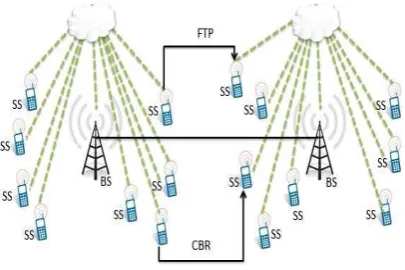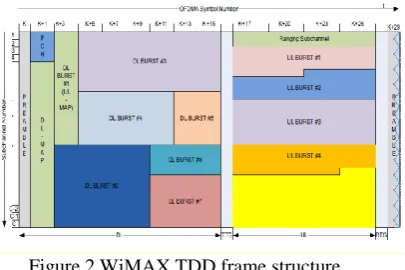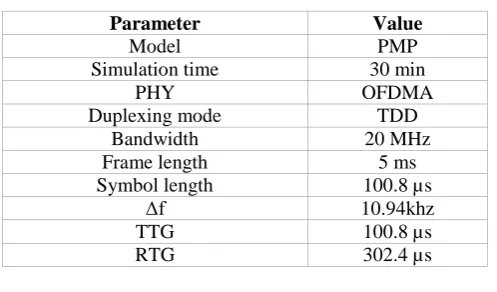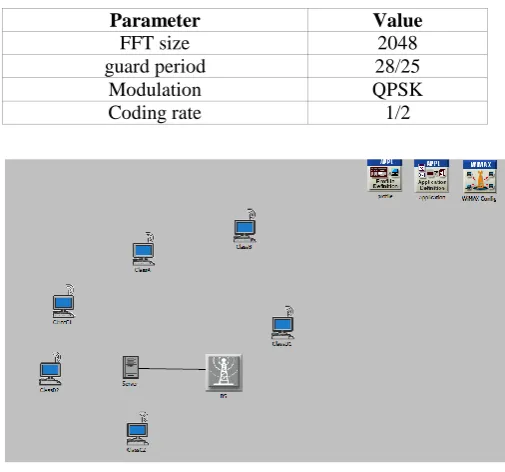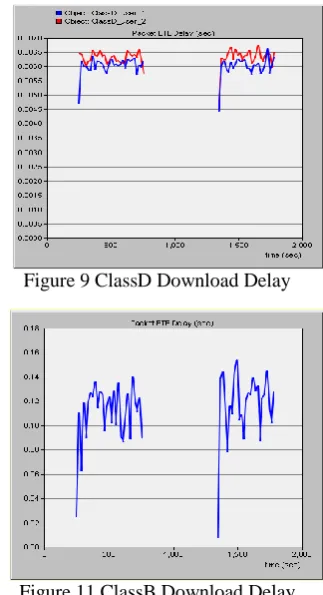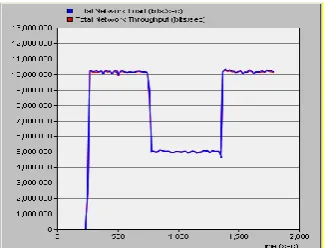IJEDR1303039 INTERNATIONAL JOURNAL OF ENGINEERING DEVELOPMENT AND RESEARCH | IJEDR Website: www.ijedr.org | Email ID: editor@ijedr.org 186
Effective Bandwidth Utilization in WiMAX Network
1
Mohamed I. Yousef,
2Mohamed M. Zahra,
3Ahmed S. Shalaby
1
Professor, 2Associate Professor, 3Lecturer
Department of Electrical Engineering, Faculty of Engineering, AL-Azhar University, Cairo, Egypt 1asalah951@yahoo.com
Abstract— Recently, Worldwide interoperability for Microwave Access (WiMAX) emerged as a grand low cost solution for last mile communication. It can also grant an easy solution for internet access specifically in rural areas. This paper highlights the problem of dissipated part of allocated bandwidth in TDD WiMAX network by establish a mechanism to redistribute the allocated bandwidth between the logical uplink sub-channel and downlink sub-channel part according to the current state of the network and the Quality of Service (QoS) requirements. Through OPNET system simulation, the results verify that the proposed scheme can enhance the overall network throughput and offer a flexible and healthy system and also can decrease about 87% of the total WiMAX delay.
Keywords - MAC, WiMAX, throughput, delay, QoS.
I.INTRODUCTION
The WiMAX technology, based on the IEEE 802.16 standards, is a vital solution for last-mile broadband wireless connectivity. Due to low cost and high speed data over a wide area, WiMAX technology is expected to meet the requirements of a huge diversity of users. WiMAX technology can cover up area about 35 miles when using 2.3–2.7 GHz [1]. The data rate can achieve up to 70 Mbps enabling WiMAX to serve all subscriber Stations (SSs) with the QoS demands and to support different kinds of services in many applications such as video conferencing, voice over IP (VOIP) and web browsing. The IEEE 802.16 working group takes the Professional commitment for developing the IEEE 802.16 standard and its extensions. The first extension named IEEE802.16a which operates in 2–11 GHz frequency band. In the lower frequencies operate in Non Line-Of-Sight (NLOS) propagation between the Base Station (BS) and the SSs. The IEEE 802.16c operates in the licensed frequency band of 10–66 GHz which uses LOS propagation and adding support for Multiple Input Multiple Output (MIMO) antennas. The IEEE 802.16-2004 which known as fixed WiMAX which support both Time Division Duplex (TDD) and Frequency Division Duplex (FDD) Service modes. This extension utilizes Orthogonal Frequency Division Multiplexing (OFDM) 256-FFT (Fast Fourier Transform) and enhances the polling mechanism. The IEEE 802.16e-2005 which adds mobility for the WiMAX technology with movement speed up to 100 Km/h, this extension utilizes Orthogonal Frequency -Division Multiple Access (OFDMA).
The IEEE 802.16f which aims to supply a detailed description protocol to manage information between BS and SSs. The IEEE 802.16g extension which aims to permit coexistence between fixed wireless access networks operating in the unlicensed bands [2].
II. WIMAX PHY TECHNIQUE OVERVIEW
In general there is small confusion about the “WiMAX standard”. WiMAX is not a standard; it is a marketing trademark type to express the IEEE 802.16- based technology. The IEEE 802.16 MAC layer is divided into three sub-layers. The lower one is called Privacy sub-layer, which responsible for security, handling authentication and encryption. The core is called MAC Common Part Sub-layer (CPS) which take the responsibility for segmentation, fragmentation, bandwidth allocation, scheduling and QoS control. The third sub-layer which responsible for classifying external service data unit called Convergence sub-layer.
Wimax Architecture
WiMAX network is composed of at least on BS and on or more SSs as shown in Fig. 1, the transmission of data by a diversity of transmission modes called Point to Multipoint (PMP) and Mesh mode [3]. In the PMP mode the SSs can only communicate through the BS, in this mode BS take the responsibility of transfer data between devices, it considered centralized control device. In Mesh mode SSs can communicate directly with each other or to expand the coverage of WiMAX network.
IJEDR1303039 INTERNATIONAL JOURNAL OF ENGINEERING DEVELOPMENT AND RESEARCH | IJEDR Website: www.ijedr.org | Email ID: editor@ijedr.org 187 Duplexing Techniques
The basic feature of The WiMAX MAC protocol is the duplexing techniques for allocating uplink sub-channel (from BS to SS) and downlink sub-channel (from SS to BS). The selection of duplexing techniques may influence physical parameters in addition to impact the characteristics that can be maintained. There are two duplexing modes (FDD and TDD) to implement [4]. In FDD, the uplink and downlink sub-channel operate on non-overlapping separate frequencies, separated by guard band. This mode allows each BSs and SSs to transmit and receive simultaneously. In TDD, (used in this paper) the time is divided between the uplink and downlink sub-channel which operate on the same frequency, but don’t transmit and receive simultaneously.
In this mode a guard time is obligatory to permit the BS and SSs to send and receive in the same frequency as shown in Figure (2). The time gab which permit the BS to switch from transmit mode to receive mode is called Transmit-receive Transition Gap (TTG) and the time gab which permit the SS to switch from receive mode to transmit mode is called Receive-transmit Transition Gap (RTG).
WiMAX physical symbol structure consists of Data, Pilot and Null sub-carriers. The Data sub-carriers used for data transmission, the Pilot sub-carriers used for synchronization and estimation function. The Null sub-carriers used for guard bands and DC carriers. Active sub-carriers are grouped into sub-channels. The WiMAX OFDMA PHY support sub-channelization in both uplink and downlink sub-channel [5].
Frame Structure
A slot is the smallest amount frequency-time resource a user can be contracted. Every slot has 48 sub-carriers. The MAC Packet Data Unit (MPDU) is the data unit used to exchange data between MAC layers of BS and SSs. The IEEE 802.16 standard defines a number of MAC management messages to be transmitted between the SSs and BS before actual data transfer [6]. The time is divided into equal length called MAC frames. As shown in Fig. 2 the MAC frame starts with downlink sub-frame which consists of preamble followed by a header to synchronize SSs with the BS followed by Downlink MAP (DL-MAP) and Uplink MAP (UL-MAP) message and one or more downlink burst.
Figure 2 WiMAX TDD frame structure.
The DL-MAP specifies the allocation of the transmission bursts along with SSs while the UL-MAP specifies bandwidth allocation and burst profiles such as the modulation technique and coding rate in the uplink. The downlink sub-frame followed by TTG gab followed by Uplink sub-frame followed by RTG gab. The uplink sub-frame consists of one or more uplink burst. The ranging sub-channel part is responsible of the scanning the UL MAP message in each frame.
III.RELATED WORKS
WiMAX network attract many researchers investigate the obstacles appear in WiMAX networks. For long time the QoS parameters take the huge part of the researcher’s interest. In a few words a description for some of the accessible research, several researchers anticipated in modifying scheduling algorithms. Wei Nie etal [7] propose a two step scheduling algorithm with support for quality of service and fairness guarantees for downlink traffic in a WiMAX network. Baban, Shaswar [8] establish a modified version of a scheduling algorithm which can adapt to alterations in users’ channel conditions.
Narang, etal [9] compare between different scheduling algorithms to find the appropriate algorithm for each traffic type. Radio resource management which still an open issue also magnetize enormous researchers. Hua Wang etal [10] propose a downlink resource management framework for QoS scheduling in OFDMA based WiMAX systems. This framework consists of a dynamic resource allocation module and a connection admission control module.
A two step hierarchical scheduler is developed for the dynamic resource allocation module, which can provide more organized service differentiation among different service classes. Ansari, etal [11] Propose algorithm takes into account the present utilization of downlink and reallocates a certain quantum of free resources to uplink.
IV. PROBLEM DESCRIPTION
As the wireless resources is limited and Telecommunication operators looking for more efficient use of the wireless scarce resources. Effective utilization of channel bandwidth is the most important goal in the algorithm design. In general QoS suggests guaranteeing a certain level of performance to the data stream. This means to be able to support delay and jitter sensitive applications like VOIP and Video conferencing.
IJEDR1303039 INTERNATIONAL JOURNAL OF ENGINEERING DEVELOPMENT AND RESEARCH | IJEDR Website: www.ijedr.org | Email ID: editor@ijedr.org 188 allocated time slots for downlink. In other locations the downlink traffic may possibly go beyond the allocated slots for downlink while the uplink traffic may be not exceed 10 percent of the allocated time slots for downlink. Consequently in these cases large quantity of channel bandwidth is dissipated in no useful way. As the IEEE 802.16 standard leaves the implementation of the wireless resource as an open issue. So we need to propose a scheme toallow users to utilize the idle part of the channel bandwidth when it is free.
V.PROPOSED ALGORITHM
The proposed algorithm attempt to solve the problem of abused bandwidth either the idle part was in the uplink or the downlink part. The main design goal is to achieve a flexible way to acquire high bandwidth utilization through improves the downlink (uplink) throughput as well as delay without violating the QoS properties of the other traffic part.
In WiMAX systems TDD is the elected duplexing mode due to transceiver economical cost implementations with a reduction of complexity. In this mode the frequency spectrum is fully used for both uplink and downlink traffic by both BS and SSs. The sub-carriers are divided into groups of subsub-carriers. Each group of sub-carrier shapes a sub-channel. TDD requires for each physical frame a partitioning in time into a downlink and an uplink part which are referred to as the DL sub-frame and the UL sub-frame respectively.
The proposed scheme plans to use the idle part of the downlink (uplink) the sub-channel when the other part needs an extra amount of resources. In effortless manner the scheme tray to increase (decrease) the number of OFDMA symbols assigned for downlink( uplink) if the QoS properties not established while the other part throughput equal to load and delay properties are established.
The algorithm begins with test the initial condition which state if downlink (uplink) throughput is less than the necessary load. If this condition is true, the algorithm will check the next condition which state if there is free OFDMA symbols in the uplink (downlink) part of the frame. if this condition is true, the algorithm increases (decreases) the number of OFDMA symbols dictated for downlink (uplink) step by step by one OFDMA symbol in each step through using the free OFDMA symbols of the uplink (downlink) then check the first condition until either this condition is false or the there is no free OFDMA symbol.
VI.SIMULATION MODEL
The goal of the simulation model is to evaluate the performance of the proposed algorithm using the OPNET modeler 14.5 simulator [12] where the IEEE 802.16 MAC and PHY levels have been implemented. The implementation of the MAC comprise the major characteristics of the 802.16 standard, such as fragmentation, packing, frames, bursts and MAC PDUs, connections, the contention periods and ranging.
The system simulation parameter used to configure the MAC and PHY layers are summarized in table 1. The simulations take for grant free space channel model to make it easy to express assurance of QoS. The estimated useful system capacity downloads capacity of the model ~ 8.64 Mbps and ~ 3.35 Mbps for uploads [13].
Consequently to validate the performance of the proposed algorithm we divide the simulation time into different periods. The first period starts from 0-100 s. with no uplink or downlink traffic in this period. The second period starts from 100-600 s. through this period there is no uplink traffic but the downlink traffic 10.125 Mbps. The third period start from 600-1200 s. during this period there is no downlink traffic but the uplink traffic to be 5 Mbps. The fourth period starts from 1200-1700 s. through this period there is no uplink traffic but the downlink traffic is 10.125 Mbps.
The simulation location consists of one BS and six SSs which are scattered in the region of the BS operating in WiMAX PMP mode shown in Fig. 3. The six Subscriber Stations is divided into four dissimilar classes of user. ClassA single user has large amount of data to download about 4.225 Mbps. The second type of user called ClassB is also single user has reasonable amount of data to download with 2.8 Mbps download traffic rate. The third type of user called classC which is two users have small amount of data to download about 0.8 Mbps. The last type of user called ClassD where two users have to send 2.5Mbps and receive 0.750 Mbps.
VII.RESULTS AND DISCUSSION
In this section the simulation is performed for two scenarios. The initial Scenario represents the default or the original construction of the IEEE 802.16e MAC without any modification. The second scenario represents the modified version of the IEEE 802.16e MAC with the proposed scheme.
TABLE I. SIMULATION PARAMETERS
Parameter Value
Model PMP
Simulation time 30 min
PHY OFDMA
Duplexing mode TDD
Bandwidth 20 MHz
Frame length 5 ms
Symbol length 100.8 µs
Δf 10.94khz
TTG 100.8 µs
IJEDR1303039 INTERNATIONAL JOURNAL OF ENGINEERING DEVELOPMENT AND RESEARCH | IJEDR Website: www.ijedr.org | Email ID: editor@ijedr.org 189
Parameter Value
FFT size 2048
guard period 28/25
Modulation QPSK
Coding rate 1/2
Figure 3 Simulation Scenario
The results for the initial scenario are shown in Fig. 4 -12. The total system delay is illustrated in Fig. 4. To analyze this Figure the time can be divided into three different periods. From 250-750 s. the total delay is about 120 ms. From750-1350 s. the system delay is about 318 ms. from 1350-1780 s the delay about 125 ms.
The total loads in association with whole throughput of the system are demonstrated in Fig.5. As shown in this illustration it can be observed that the load is about 10.2 Mpbs for the time period form 250-750 s. while the throughput is about 8.5 Mbps. From 750-1350 s. the total load is therefore 5 Mbps while the total throughput is 3.3 Mbps. From 1350-1780 s. the total load is 10.2 Mbps while the total throughput is 8.55 Mbps. So this scenario experiences the problem of dissipated bandwidth. The amount of lost data is 1.7 Mbps.
The percent of frame usage is shown in Fig. 6 which indicates that the frame is completely used for both uplink and downlink for all time. The number of OFDMA symbols used is shown in Fig. 7 for both downlink and uplink part which is constant equal to 46000 and 17200 symbols respectively.
Figure 4 Total WiMAX Delay
IJEDR1303039 INTERNATIONAL JOURNAL OF ENGINEERING DEVELOPMENT AND RESEARCH | IJEDR Website: www.ijedr.org | Email ID: editor@ijedr.org 190 Figure 6 Frame Usage
Figure 7 Frame size
The delay for each class of user is characterized in Fig. 8-12. As shown in these illustrations it can be declared that the End To End (ETE) delay of 320ms for the upload part of the ClassD users and about 6ms for the download for the same class user. The ETE delay of 10 ms for the download ClassC users while ClassB user suffers from (100-140) ms. ClassA user suffers from about 197 ms.
Figure 8 ClassD Upload Delay Figure 9 ClassD Download Delay
Figure 10 ClassC Download Delay Figure 11 ClassB Download Delay
The characteristics of the second scenario are symbolized Fig. 13-21 where the proposed scheme used in this setting. As shown in Fig. 13 the total system delay swing between (30-40) ms and can’t exceed 55ms in worst case. This indicates decrease about 87% of the total system delay.
Figure 12 ClassA Download Delay
IJEDR1303039 INTERNATIONAL JOURNAL OF ENGINEERING DEVELOPMENT AND RESEARCH | IJEDR Website: www.ijedr.org | Email ID: editor@ijedr.org 191 Figure 14 Total WiMAX Load & Throughput
Figure 15 Frame Usage
Figure 16 Frame size Figure 17 ClassD Upload Delay
Figure 18 ClassD Download Delay
Figure 19 ClassC Download Delay
Figure 20 ClassB Download Delay Figure 21 ClassA Download Delay
The total network load and throughput are given in Fig. 14 which clarify that total network load and throughput are identical. This demonstrates the improved part of our goal there is no dropped data. The frame usage is shown in Fig. 15 which confirms the improvement made in this scenario. The number of OFDMA symbols used is shown in Fig. 16 for both downlink and uplink part which indicates that the number of OFDMA symbols is not constant. It implies that the number of OFDMA symbols for upload or download part can be increased or decreased according to the current state of the network.
IJEDR1303039 INTERNATIONAL JOURNAL OF ENGINEERING DEVELOPMENT AND RESEARCH | IJEDR Website: www.ijedr.org | Email ID: editor@ijedr.org 192 VIII.CONCOLOUTIONS
This paper introduces a modified version WiMAX Base Station MAC construction in PMP mode. The algorithm intends to improve the overall throughput of WiMAX network as well as toreduce the whole system delay. According to the requirements of the users and the current state of the network the proposed scheme change the number of OFDMA symbols in TDD mode reserved for Downlink or the uplink part. By increasing or decreasing the number of OFDMA symbols to certify the QoS constraints. The simulation results prove that the proposed scheme can provide a solution for the problem of dissipated part of the assigned bandwidth and can reduce the whole system delay by 87%.
REFERENCES
[1] Wail Mardini, Mai M. Abu Alfoul “Modified WRR Scheduling Algorithm for WiMAX Network” Dept. of Computer Science, Jordan University of Science and Technology, Technical Report, Vol. 3, No. 2, 2011.
[2] Pratik Dhrona “A performance Study of Uplink Scheduling Algorithms in Point to Multipoint WiMAX Networks” MSc. thesis, Kingston, Ontario, Canada, 2007.
[3] Ala'a Z. Al-Howaide, Ahmad S. Doulat and Yaser M. Khamayseh “Performance Evaluation of Different Scheduling Algorithms in WiMAX” IJCSEA Vol.1, No.5, pp. 103-115, October 2011.
[4] Supriya Maheshwari,”An Efficient QoS Scheduling Architecture for IEEE 802.16 Wireless MANs” Master Thesis, IIT Bombay, 2005.
[5] Ashraf Nusairat, “Scheduling for Throughput Optimization in WiMAX Networks” PhD Thesis, IIT Chicago, May 2011. [6] Mikael Gidlund, Gang Wang “Uplink Scheduling Algorithms for QoS Support in Broadband Wireless Access Networks”
Journal of Communications, Vol. 4, No. 2, pp. 133 – 142, March 2009.
[7] Wei Nie, Houjun Wang, and Jong Hyuk Park, “Packet Scheduling with QoS and Fairness for Downlink Traffic in WiMAX Networks ” JIPS, Vol.7, No. 2, June 2011.
[8] Baban, Shaswar, “Design and Implementation of a Scheduling Algorithm for the IEEE 802.16e (Mobile WiMAX) Network”, MSc. Thesis, University of Westminster, September, 2008.
[9] Mohita Narang, Amardeep Kaur “Comparative Study of QoS Scheduling Algorithms in WiMAX” IJARCSSE, Vol. 3, Issue 8, August 2013.
[10] Hua Wang , Lars Dittmann “Downlink resource management for QoS scheduling in IEEE 802.16 WiMAX networks” Computer Communication 33, pp. 940 -953, 2010.
[11] A. Q. Ansari, Et al ”Optimizing WiMAX: A Dynamic Strategy for Reallocation of Underutilized Downlink Sub-Frame to Uplink in TDD Mode” IJCNS, 2, PP. 888-894, 2009.
[12] www.opnet.com
